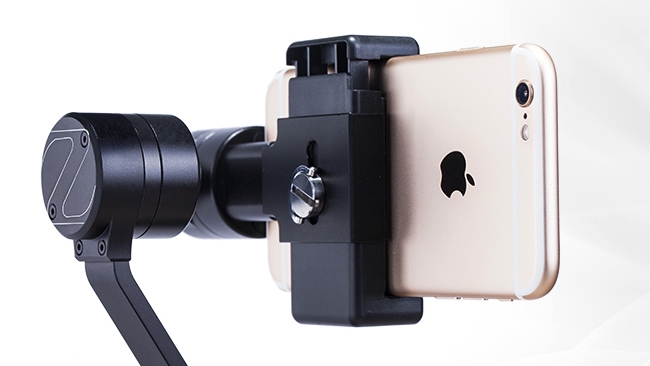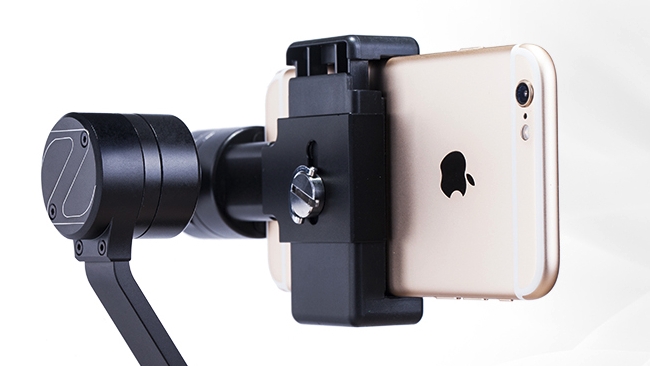
 Zheyun's Smooth C gimbal
Zheyun's Smooth C gimbal
The Zhiyun Z1 Smooth C & Evolution illustrate well the rather astonishing progress that one area of the industry in particular has made in recent years.
3 Axis gimbals are one of the best inventions for video in recent years. I'm not sure that Garrett Brown, the inventor of the Steadicam, would agree with that sentiment, but they have opened up really good stabilisation to users, without the need for years of practice just to walk in a straight line correctly.
It does stand without saying though, that the Steadicam and similar devices are still the kings of stabilisation, due to the fact that they more easily stabilise horizontal and vertical slip, as well as the rotational movements that the 3 axis gimbals generally correct.
But it remains that motorised gimbals are "good enough" for a large number of people, and they are generally simple to operate.
Recently a company called Zhiyun has developed a range of gimbals for all manner of camera sizes. But the focus of this review are the Z1 Smooth C and the Evolution models, which are designed for use with smart phones and GoPros respectively.
What's in the box?
Both gimbals come very neatly packed and at first glance they seem pretty similar. They are both of a fairly similar size, give or take, and at first it seems that both take the same batteries. The Evolution model, it turns out, can also use some larger, higher powered batteries by way of an extension tube attachment.
In general design terms, both gimbals consist of a handheld tube, into which the batteries slot in by way of a removable bottom cap. At the top of both tubes are the main gimbal controls. It is here that the two different models vary slightly. The Smooth C uses four buttons for gimbal control, and a central one for mode control, while the Evolution has a mini joystick, which is pressed for the different modes. It is a mystery to me why there is such a difference. The joystick version gives more control over the speed of the gimbal movement, while the movement using the buttons is binary in speed. Both models have a power button on the side of the main tube.
Aside from the 3 motors for the different axis up top, that's all there is to the main design.
Build quality
Both devices feel good in the hand. Solid, but not overly heavy. The main tube is made from metal on both models, and they both feel reassuringly sturdy.
The Smooth C holds the smart phone by way of a vertical clamp. This is pretty darn strong, so there appears to be no worries about the phone falling out. The Evolution is slightly different in that there is a metal frame that loosens off with some hand turned screws, the camera then slides in, before the clamp is then screwed in tightly to keep the camera in place. This system allows cameras of different depth measurements to be attached to the device.
Care must be taken to butt the cameras as far up against the motor sides as possible, otherwise vibration might be an issue due to imbalance. One thing of concern is that when the gimbal is put into standby mode or switched off, the camera will drop, due to no power in the motors, and risk hitting the lens on one of the motor edges. Zhiyun has addressed this and has supplied a piece of adhesive padding, which is put onto one of the motors to offer a cushion should this happen. This didn't solve the problem fully with my iPhone 6 since there were still edges that the lens risked hitting, and indeed did so on one occasion. So be mindful of this when you are using them.
Zhiyun also supply a battery charger, which is powered by a standard USB connection, and on the Evolution model there is a handy connector to allow the GoPro to be powered by the gimbal batteries. This is a very useful addition since many of the GoPro's are not exactly renowned for their battery duration. Particularly as you will want to be using the gimbal with the GoPro touch screen back rather than the Battery Back so that you can frame the shots properly.
In action
The Gimbals come pretty much ready to go. Although if you notice some skew horizons you may need to go through a calibration process. This can be performed with or without connection to a computer. Although I would recommend the latter. When connected to a computer you will need to download some drivers and software from the Zhiyun website, and then hook up the gimbal to your machine with the supplied USB cable.
The calibration order is the same for both the offline and online methods. There are diagrams that are supplied in the instructions as well as on screen in the computer app. These aren't entirely intuitive or easy to decipher, it has to be said. So you will need to pay keen attention to the orientation of the motors shown in each calibration position. As well as taking the time to find a decent flat surface and a way of supporting the handle level while the process is gone through.
Hopefully you won't have to do this process too often and your gimbal will be ready to go. Simply press the power button, which puts the gimbals into standby mode, and then either press and hold down the joystick or the central control button depending on the model, and the gimbal will come alive! Holding down the same button or joystick will place the gimbals back into standby mode to conserve power.
The motors are extremely responsive, and I found it pretty much impossible to catch them out. By default both devices switch on in Follow mode. In other words you can control the pitch up and down with the joystick or control buttons, but horizontal rotation will follow the orientation of the handle. This is the most intuitive and useful mode to be in, and will be the one most people will use.
By single pressing the central button or joystick, the gimbals can be put into a Locked orientation mode, which keeps the camera facing a fixed direction, unless you control the pan and tilt manually. To my mind the buttons and joystick do not offer the fine control necessary to make this mode fully practical, but it is there as an option none the less, and may come in handy for some. The joystick offers a bit more fine control, so of the two models the a Evolution is the one that handles this best.
The third mode, entered by double button or joystick press, allows vertical tilt and pan to be controlled by the orientation of the handle, but locks the roll axis. The camera roll can then be adjusted with the left and right controls along the z-axis, allowing for some creative "Dutch Tilt" style shots. Once again I see this as more of a novelty mode and I feel that most users will be happiest using the devices in their default Follow mode. A single press of the central button or joystick cycles back to this mode of operation.
The Evolution model offers a fourth mode, which allows low mode operation so that you can get the camera right down to floor level. Of all the secondary modes, this one will be very useful. Either for following the cat, or filming skateboard videos!
Because such devices cannot correct for X and Y axis "slip" like a Steadicam can, you will need to take care about absorbing walking movement through your arms to minimise "walkiness", a slight vertical and horizontal bobbing that stops the movement from being truly like a dolly shot. This affects most motorised gimbals, and it also affects Steadicam until the operator becomes good at what they do. But again it is something to be mindful of.
DJI have solved the vertical bobbing on their Osmo gimbal by selling an additional spring loaded attachment, which acts as a sort of micro Steadicam style arm, absorbing the vertical movement. This might be something that Zhiyun would like to consider as an add on, since it can make a huge difference to the shot.
The Evolution model is also capable of outputting analogue composite video via a 3.5mm jack, and both gimbals can be fitted with a USB controller to allow motor control via a wired system.
Professional use?
Operating the Smooth C and the Evolution is a lot of fun, it has to be said. But do they have a professional application given the cameras that they deploy? It depends, is my answer to that one. Their size means that they could be attached to cars, or mountain bikes. In fact Zhiyun even make a helmet attachable gimbal called the Rider, as well as handlebar mounts for the handheld systems. For specialist use I could fully see them being utilised in some way, even if it was for the lower budget end of things.
Used with an iPhone 6S and the Filmic Pro app, some surprisingly high quality footage, both in slow motion and in normal speed 4K can be captured at pretty reasonable bitrates with the Smooth C. If you wanted to be discrete, both devices could be pretty useful, certainly for a lot of action sports.
The price for both systems is very reasonable at £135 for the Smooth C and £199 for the Evolution (both prices ex VAT), especially when you consider that DJI's Osmo is over the £400 mark in its base form, with a similar quality to a GoPro Hero4 Black. The Osmo has an advantage in that it will be able to run the X5 series of cameras, but the price difference is so large that for those on a tight budget the decision will be an easy one. Especially if you already own a GoPro or smartphone with decent video recording (and yes, I am aware that some will see that as an oxymoron!)
Conclusions
Zhiyun have made two very cool little products here, and at a price that won't turn people off. If I had one real gripe, and this goes for all other makes and models too, it is that the issue of waterproofing hasn't been addressed. I would love to use such a system on a kayak mount, or when I am out in horizontal rain on a Scottish or Alpine river. Even the risk of splashing it on a sunny day means that there is a risk of damaging it, particularly near the sea.
But I will admit that my request is rather a niche one! But one that I do think needs addressing by somebody, somewhere.
That said, the Zhiyun Smooth C and Evolution are well made, solid, and operate very nicely. I found battery life to be very good indeed with the supplied single cell Lipos. Zhiyun claim 12 hours of continuous operation for the Evolution. And while I haven't operated it for that length of time, I can say that I didn't find power usage to be an issue. Although being powered by Lipos always take care when charging them, and do not leave them alone hooked up to a charger without someone present. The gimbals themselves have voltage protection built in to prevent cell damage, but the chargers, while they will tell you when the battery is charged, are not recommended to stay turned on with batteries in them indefinitely.
As I mentioned, these devices are a lot of fun to use, and I can certainly recommend them if you use a GoPro or smartphone for video a lot. Now if only the waterproofing could be addressed I would be a very, very happy fellow!
Tags: Production


Comments